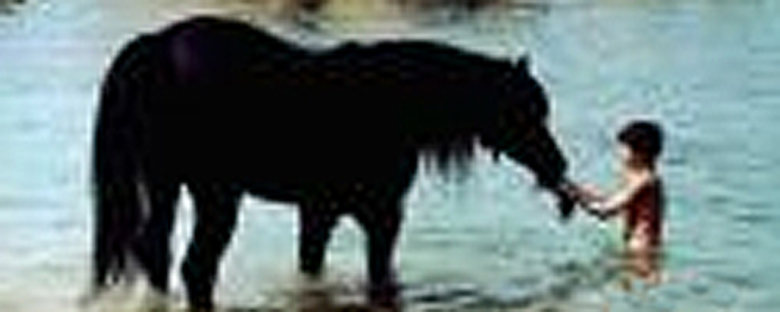Reviews
There is a long moment when a boy and horse, sole companions from a shipwreck, regard one another. The two have spent an indeterminable amount of time on a deserted island, focused on self-survival, and now find that a curiosity overcomes their reserve and their loneliness. The boy holds out seaweed, perhaps kelp, and offers this to the jittery horse. Although both hesitate for some time, the horse accepts this gesture and their bond is solidified. A deliberate patience characterizes this scene, and it is only one of the qualities that distinguish Carroll Ballard’s film, The Black Stallion. Based on Walter Farley’s 1941 children’s classic, the film concerns the story of the companionship of the boy, Alec, and “The Black,” their rescue from a shipwreck and eventual championship racing. The plot is straightforward enough for generic adaptation but what Ballard has accomplished is a lyrical and rather transcendental experience.
Prior to the shipwreck we meet Alec and his father during a journey home aboard the steamship Drake. Ballard invokes ancient storybooks and authors such as Robert Louis Stevenson, whose inspiration is confirmed as Alec’s father plays cards with a cast of characters who could easily rent rooms at The Admiral Benbow (the troupe antes jewels and ivory edged weapons as bets). A sense of destiny is infused in the chance meeting of Alec and this horse aboard the ship, connecting it with the gift that Alec’s father bestows: a pewter horse he claims as Bucephalus, mythical horse of Alexander the Great. These small details enrich and set the tone, only intensifying as the ship is struck and sinks in a frightening sequence, leaving Alec and The Black stranded alone on the island.
Nearly half of the film focuses on the companionship formed between the boy and horse on the deserted island, in remarkable scenes that do not romanticize the situation but instead convey the loneliness of a child who has not only lost his father through disaster, but now needs to grow up rather quickly if he is to survive. Caleb Deschanel’s cinematography captures this seclusion as Alec wanders through endless stretches of sand and learns to forge for food. The return to a primal state is enhanced with the boy’s near spiritual friendship with The Black, a connection defined in practicality to curb solitude, but with an implied air of fate. While the soundtrack suggests a mystical quality with musical references of Arabia and the ancient East, the shots of Alec thundering along the beach on The Black suggest a connection of the two through nature, unaffected and organic. Children and animals, more often the small and fuzzy kind, are sensibly connected for a shared cuteness or innocence; here the correlation stems from mutual respect and a genuine understanding that the natural world has instilled in both creatures.
The pair is eventually rescued and returned to civilization in Alec’s upper class neighborhood. This ordered world is not as absorbing as the wild, and far more conventional. There are expected hijinks as the horse becomes accustomed to backyards and traffic, but there is also an anticipation as Alec trains The Black for a race at Belmont. Alec, accomplished at spearing fish and avoiding dehydration, feels disconnected at school and at home, where he sleeps on the lawn rather than in bed. There is solace when Alec discovers the racetrack, befriending an old racing pro (Mickey Rooney in a sweetly nostalgic role) and slowly regains his autonomy in training The Black. Ballard completely alters the aura of a racetrack; although the monetary benefits are obvious for a down on his luck jockey and the half orphaned Alec, the track also becomes the place where Alec and The Black find their Walden within suburban confines. The link made on an anonymous beach is made stronger while the two fervently practice in midnight runs around the track, and ultimately in the Belmont race that returns Alec and the viewer to the island. In the exquisitely edited finale there is a combination of meticulous sound design, as the din of the crowd dissolves into the quiet soundtrack of the beach, juxtaposed with images of Alec’s memories of the island.
It is difficult to describe a film as having a magical quality without a response of rolling eyes, or immediately preparing for defense against cynicism (particularly when you yourself are often guilty of such reactions). Describing The Black Stallion with any other adjectives isn’t quite sufficient; it is admirable in that it manages to inject feelings and qualities so often associated with children — a sense of wonder, breathlessness, and exploration — and persuades us to recall these feelings as adults. In that final race it is so thrilling to watch Alec and The Black furiously push their way to the finish line, but what is far more exhilarating is hearing the sound dissolve from the cheering crowd to calm quiet, a stalled moment that recalls the two alone on the island. It celebrates nature, certainly kinship and the joys of victory, but what I find most enduring is the ability of this film to keep my heart in my throat even upon repeated viewings.
We don’t do comments anymore, but you may contact us here or find us on Twitter or Facebook.



